Abstract
Evidence is presented which reinforces the complexity of the host-parasite interaction during the course of syphilis. Infection with Treponema pallidum evokes a complicated antibody response and an assortment of cell-mediated immune reactions in the host. It appears that humoral immunity plays a minor role towards the complete elimination of syphilitic infection while the cellular limb of the immune response may be an important host defence mechanism. Information now available indicates that a state of anergy, or immunosuppression, exists in the early stages of human and experimental rabbit syphilis based upon negative skin reactions to T. pallidum antigen(s), the abnormal histological appearance of lymphoid organs, and impaired in vitro lymphocyte reactivity. It is also evident that in the later stages of the disease cellular immunity becomes activated as delayed type skin reactions can normally be elicited in tertiary syphilitics and lymphocyte behaviour in cell culture appears normal. Several mechanisms have been invoked to explain the delay in an effective immune response against syphilitic infection and the duration of the disease: (1) a capsule-like substance on the outer surface of virulant T. pallidum may act as a barrier against treponemicidal antibody; (2) this material and other biological properties of virulent treponemes could enable spirochaetes to escape being engulfed by macrophages and other phagocytic cells; (3) antigenic competition among different treponemal antigens causing partial tolerance; (4) T. pallidum infection may bring about the elaboration of immunosuppressive substances of host or treponemal origin which inhibit the proper function of lymphocytes, macrophages, and other cell types.
Full text
PDF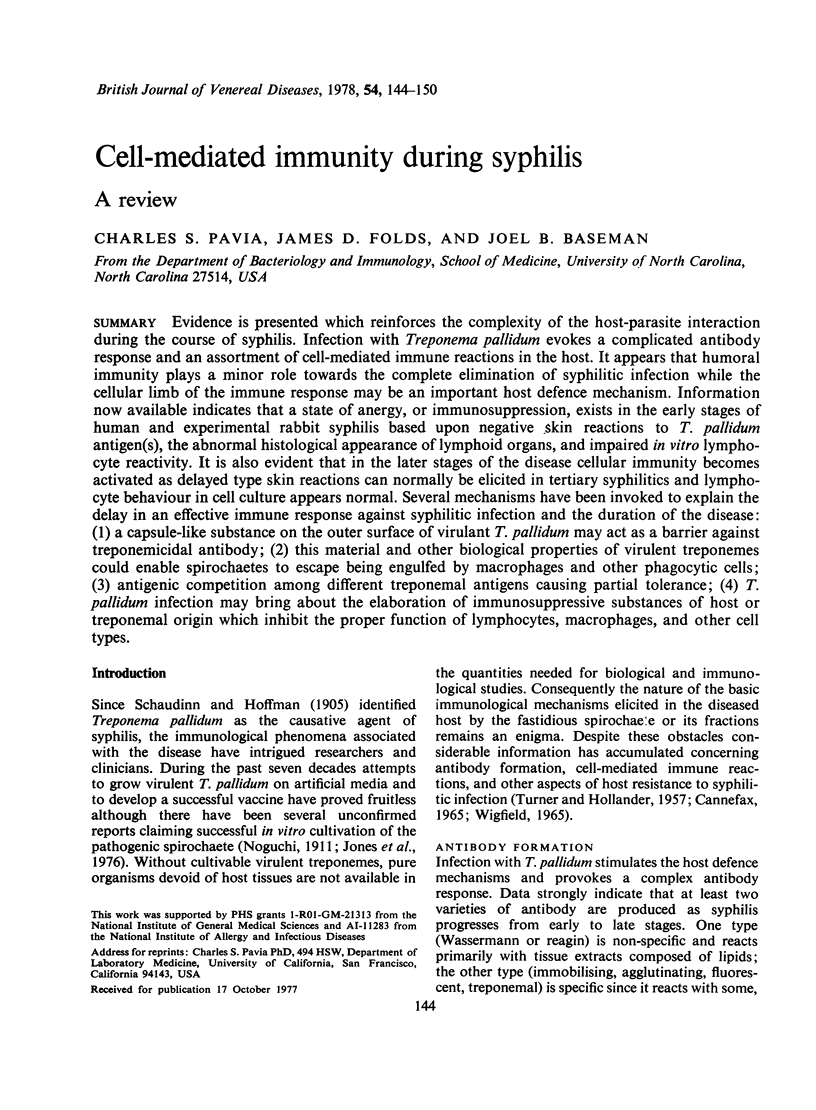
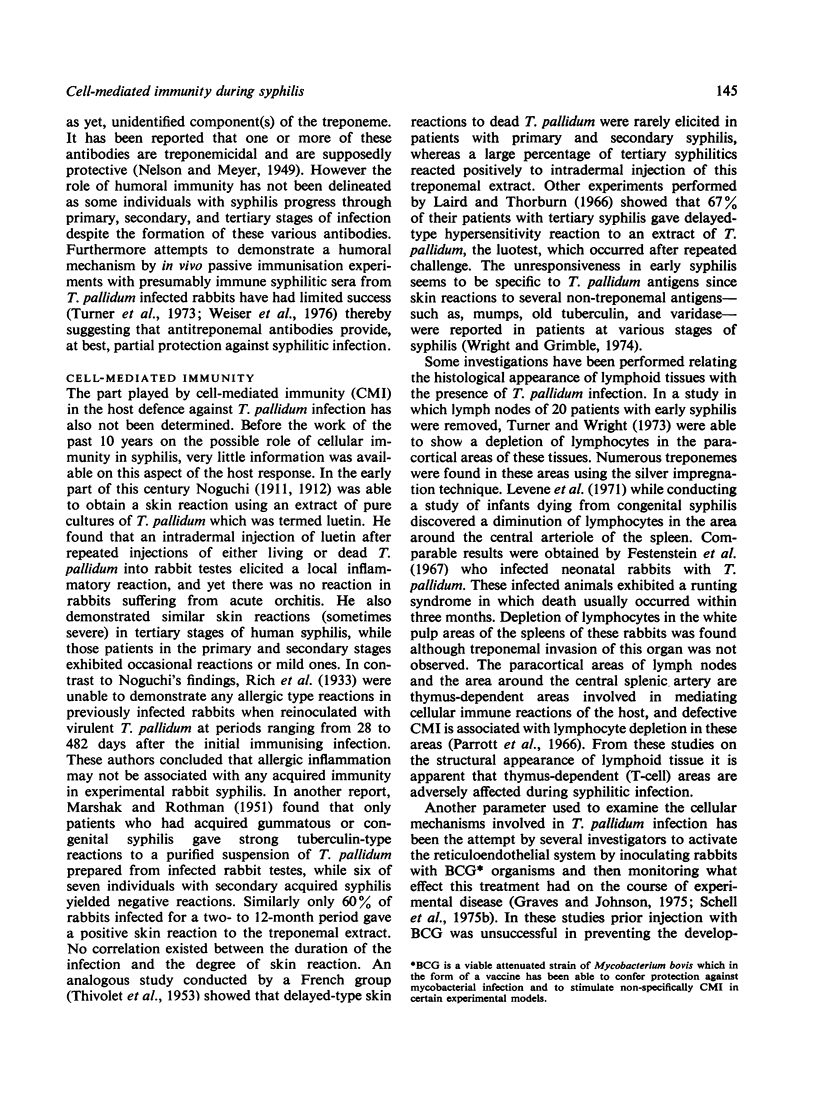
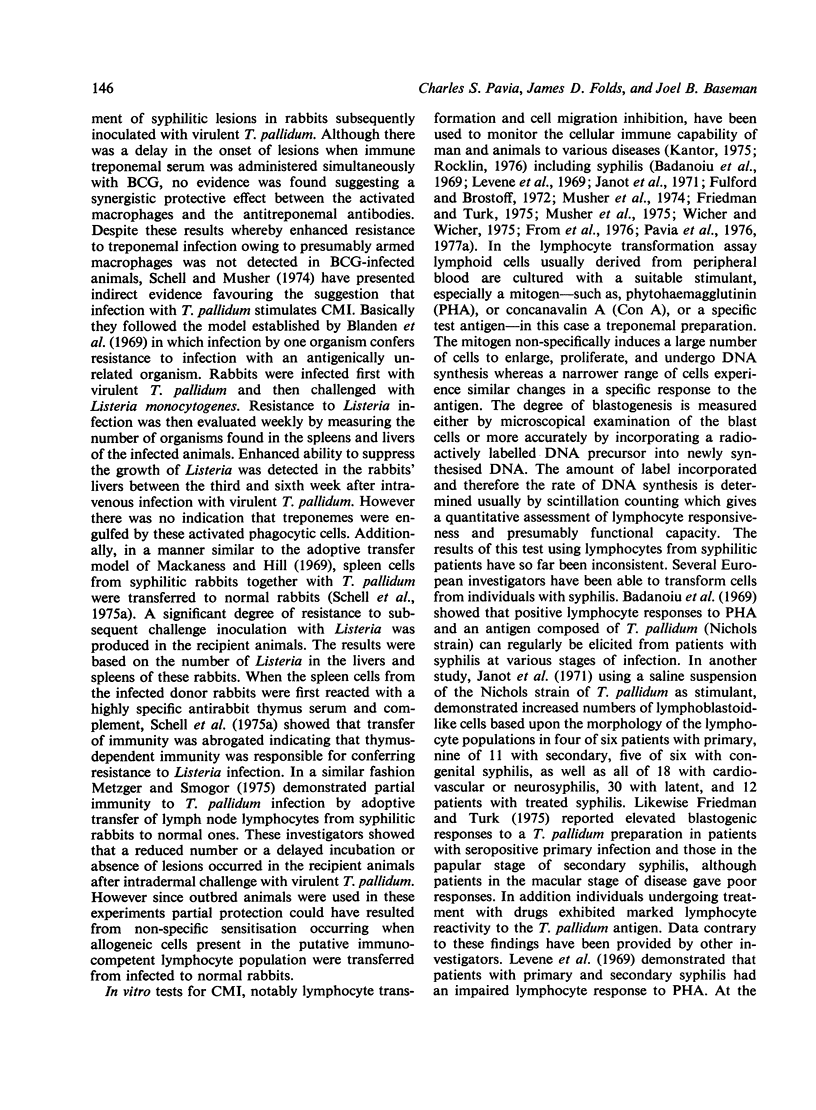
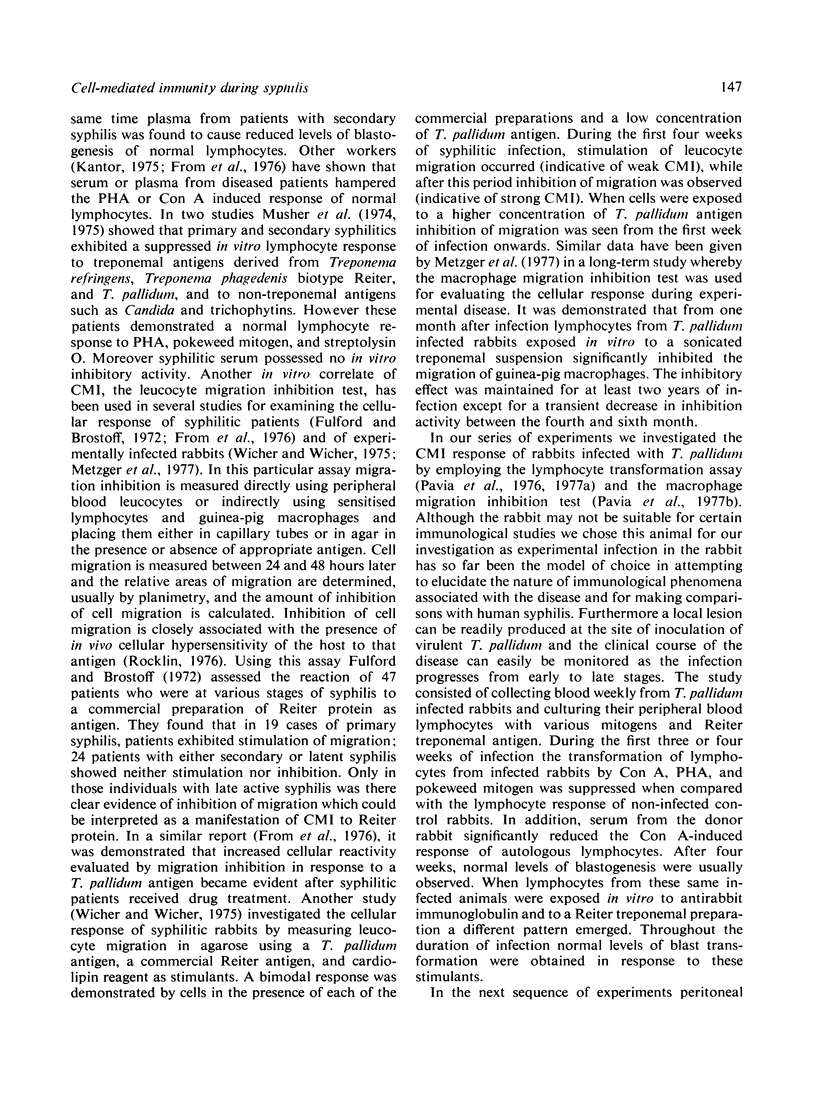
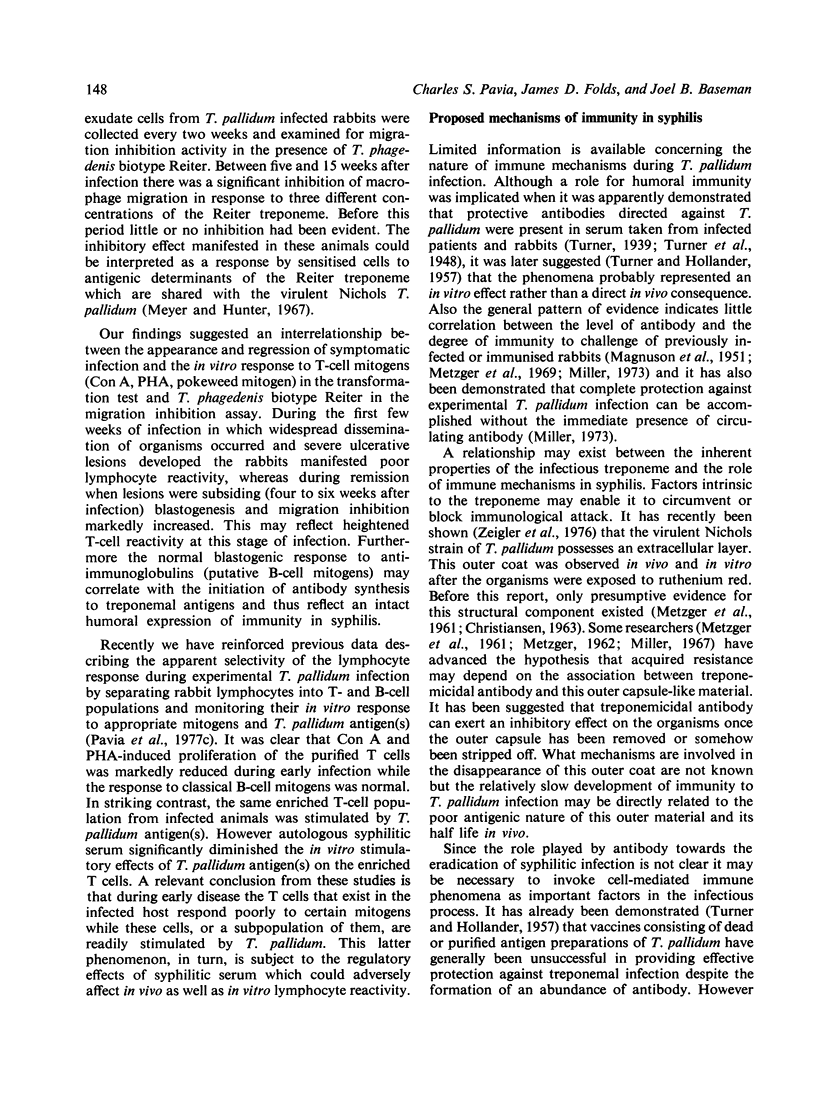

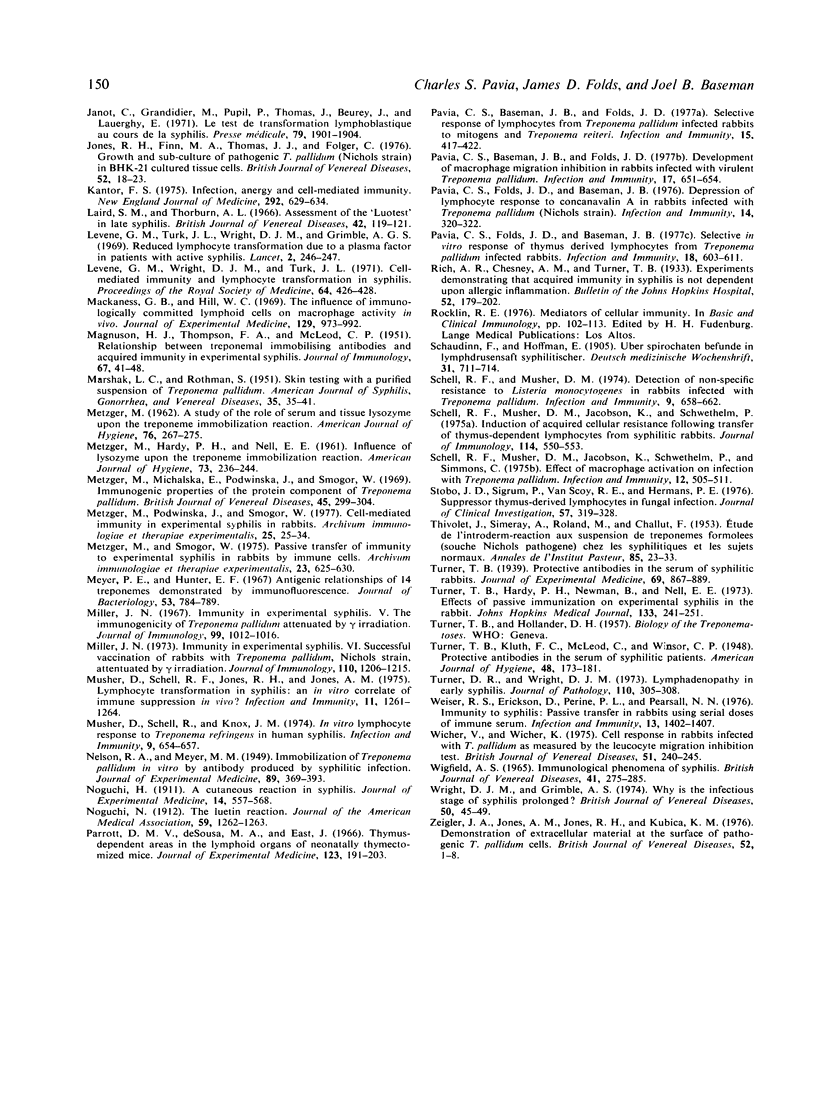
Selected References
These references are in PubMed. This may not be the complete list of references from this article.
- Blanden R. V., Lefford M. J., Mackaness G. B. The host response to Calmette-Guérin bacillus infection in mice. J Exp Med. 1969 May 1;129(5):1079–1107. doi: 10.1084/jem.129.5.1079. [DOI] [PMC free article] [PubMed] [Google Scholar]
- Bădănoi A., Gavrilesco M., Nicolau G., Cîrciumaresco T. Lymphoblastogenèse immunoallergique et antigène tréponémique in vitro dans la syphilis. Arch Roum Pathol Exp Microbiol. 1969 Jun-Sep;28(2):419–427. [PubMed] [Google Scholar]
- CHRISTIANSEN S. Protective layer covering pathogenic treponemata. Lancet. 1963 Feb 23;1(7278):423–425. doi: 10.1016/s0140-6736(63)92309-2. [DOI] [PubMed] [Google Scholar]
- Cannefax G. R. Immunity in syphilis. Br J Vener Dis. 1965 Dec;41(4):260–274. doi: 10.1136/sti.41.4.260. [DOI] [PMC free article] [PubMed] [Google Scholar]
- Elberg S. S. Immunity to brucella infection. Medicine (Baltimore) 1973 Jul;52(4):339–356. doi: 10.1097/00005792-197307000-00013. [DOI] [PubMed] [Google Scholar]
- Festenstein H., Abrahams C., Bokkenheuser V. Runting syndrome in neonatal rabbits infected with Treponema pallidum. Clin Exp Immunol. 1967 May;2(3):311–320. [PMC free article] [PubMed] [Google Scholar]
- From E., Thestrup-Pedersen K., Thulin H. Reactivity of lymphocytes from patients with syphilis towards T. pallidum antigen in the leucocyte migration and lymphocyte transformation tests. Br J Vener Dis. 1976 Aug;52(4):224–229. doi: 10.1136/sti.52.4.224. [DOI] [PMC free article] [PubMed] [Google Scholar]
- Fulford K. W., Brostoff J. Leucocyte migration and cell-mediated immunity in syphilis. Br J Vener Dis. 1972 Dec;48(6):483–488. doi: 10.1136/sti.48.6.483. [DOI] [PMC free article] [PubMed] [Google Scholar]
- Graves S. R., Johnson R. C. Effect of pretreatment with Mycobacterium bovis (strain BCG) and immune syphilitic serum on rabbit resistance to Treponema pallidum. Infect Immun. 1975 Nov;12(5):1029–1036. doi: 10.1128/iai.12.5.1029-1036.1975. [DOI] [PMC free article] [PubMed] [Google Scholar]
- Hellström K. E., Hellström I. Immunological enhancement as studied by cell culture techniques. Annu Rev Microbiol. 1970;24:373–398. doi: 10.1146/annurev.mi.24.100170.002105. [DOI] [PubMed] [Google Scholar]
- Janot C., Grandidier M., Pupil P., Thomas J. L., Beurey J., de Lavergne E. Le test de transformation lymphoblastique au cours de la syphilis. Presse Med. 1971 Oct 16;79(43):1901–1904. [PubMed] [Google Scholar]
- Jones R. H., Finn M. A., Thomas J. J., Folger C. Growth and subculture of pathogenic T. pallidum (Nichols strain) in BHK-21 cultured tissue cells. Br J Vener Dis. 1976 Feb;52(1):18–23. doi: 10.1136/sti.52.1.18. [DOI] [PMC free article] [PubMed] [Google Scholar]
- Kantor F. S. Infection, anergy and cell-mediated immunity. N Engl J Med. 1975 Mar 20;292(12):629–634. doi: 10.1056/NEJM197503202921210. [DOI] [PubMed] [Google Scholar]
- Laird S. M., Thorburn A. L. Assessment of the "luotest" in late syphillis. Br J Vener Dis. 1966 Jun;42(2):119–121. doi: 10.1136/sti.42.2.119. [DOI] [PMC free article] [PubMed] [Google Scholar]
- Levene G. M., Turk J. L., Wright D. J., Grimble A. G. Reduced lymphocyte transformation due to a plasma factor in patients with active syphilis. Lancet. 1969 Aug 2;2(7614):246–247. doi: 10.1016/s0140-6736(69)90010-5. [DOI] [PubMed] [Google Scholar]
- Levene G. M., Wright D. J., Turk J. L. Cell-mediated immunity and lymphocyte transformation in syphilis. Proc R Soc Med. 1971 Apr;64(4):426–428. [PMC free article] [PubMed] [Google Scholar]
- MAGNUSON H. J., THOMPSON F. A., Jr, McLEOD C. P. Relationship between treponemal immobilizing antibodies and acquired immunity in experimental syphilis. J Immunol. 1951 Jul;67(1):41–48. [PubMed] [Google Scholar]
- METZGER M. A study of the role of serum and tissue lysozyme upon the treponeme immobilization reaction. Am J Hyg. 1962 Nov;76:267–275. doi: 10.1093/oxfordjournals.aje.a120282. [DOI] [PubMed] [Google Scholar]
- METZGER M., HARDY P. H., Jr, NELL E. E. Influence of lysozyme upon the treponeme immobilization reaction. Am J Hyg. 1961 Mar;73:236–244. doi: 10.1093/oxfordjournals.aje.a120182. [DOI] [PubMed] [Google Scholar]
- Mackaness G. B. The influence of immunologically committed lymphoid cells on macrophage activity in vivo. J Exp Med. 1969 May 1;129(5):973–992. doi: 10.1084/jem.129.5.973. [DOI] [PMC free article] [PubMed] [Google Scholar]
- Metzger M., Michalska E., Podwińska J., Smogór W. Immunogenic properties of the protein component of Treponema pallidum. Br J Vener Dis. 1969 Dec;45(4):299–304. doi: 10.1136/sti.45.4.299. [DOI] [PMC free article] [PubMed] [Google Scholar]
- Metzger M., Podwińska J., Smogór W. Cell-mediated immunity in experimental syphilis in rabbits. Arch Immunol Ther Exp (Warsz) 1977;25(1):25–34. [PubMed] [Google Scholar]
- Metzger M., Smogór W. Passive transfer of immunity to experimental syphilis in rabbits by immune lymphocytes. Arch Immunol Ther Exp (Warsz) 1975;23(5):625–630. [PubMed] [Google Scholar]
- Meyer P. E., Hunter E. F. Antigenic relationships of 14 treponemes demonstrated by immunofluorescence. J Bacteriol. 1967 Mar;93(3):784–789. doi: 10.1128/jb.93.3.784-789.1967. [DOI] [PMC free article] [PubMed] [Google Scholar]
- Miller J. N. Immunity in experimental syphilis. V. The immunogenicity of Treponema pallidum attenuated by gamma-irradiation. J Immunol. 1967 Nov;99(5):1012–1016. [PubMed] [Google Scholar]
- Miller J. N. Immunity in experimental syphilis. VI. Successful vaccination of rabbits with Treponema pallidum, Nichols strain, attenuated by -irradiation. J Immunol. 1973 May;110(5):1206–1215. [PubMed] [Google Scholar]
- Musher D. M., Schell R. F., Jones R. H., Jones A. M. Lymphocyte transformation in syphilis: an in vitro correlate of immune suppression in vivo? Infect Immun. 1975 Jun;11(6):1261–1264. doi: 10.1128/iai.11.6.1261-1264.1975. [DOI] [PMC free article] [PubMed] [Google Scholar]
- Musher D. M., Schell R. F., Knox J. M. In vitro lymphocyte response to Treponema refringens im human syphilis. Infect Immun. 1974 Apr;9(4):654–657. doi: 10.1128/iai.9.4.654-657.1974. [DOI] [PMC free article] [PubMed] [Google Scholar]
- Pavia C. S., Baseman J. B., Folds J. D. Selective response of lymphocytes from Treponema pallidum-infected rabbits to mitogens and Treponema reiteri. Infect Immun. 1977 Feb;15(2):417–422. doi: 10.1128/iai.15.2.417-422.1977. [DOI] [PMC free article] [PubMed] [Google Scholar]
- Pavia C. S., Folds J. D., Baseman J. B. Depression of lymphocyte response to concanavalin A in rabbits infected with Treponema pallidum (Nichols strain). Infect Immun. 1976 Jul;14(1):320–322. doi: 10.1128/iai.14.1.320-322.1976. [DOI] [PMC free article] [PubMed] [Google Scholar]
- Pavia C. S., Folds J. D., Baseman J. B. Development of of macrophage migration inhibition in rabbits infected with virulent Treponema pallidum. Infect Immun. 1977 Sep;17(3):651–654. doi: 10.1128/iai.17.3.651-654.1977. [DOI] [PMC free article] [PubMed] [Google Scholar]
- Pavia C. S., Folds J. D., Baseman J. B. Selective in vitro response of thymus-derived lymphocytes from Treponema pallidum-infected rabbits. Infect Immun. 1977 Dec;18(3):603–611. doi: 10.1128/iai.18.3.603-611.1977. [DOI] [PMC free article] [PubMed] [Google Scholar]
- Schell R. F., Musher D. M. Detection of nonspecific resistance to Listeria monocytogenes in rabbits infected with Treponema pallidum. Infect Immun. 1974 Apr;9(4):658–662. doi: 10.1128/iai.9.4.658-662.1974. [DOI] [PMC free article] [PubMed] [Google Scholar]
- Schell R., Musher D., Jacobson K., Schwethelm P. Induction of acquired cellular resistance following transfer of thymus-dependent lymphocytes from syphilitic rabbits. J Immunol. 1975 Feb;114(2 Pt 1):550–553. [PubMed] [Google Scholar]
- Schell R., Musher D., Jacobson K., Schwethelm P., Simmons C. Effect macrophage activation on infection with Treponema pallidum. Infect Immun. 1975 Sep;12(3):505–511. doi: 10.1128/iai.12.3.505-511.1975. [DOI] [PMC free article] [PubMed] [Google Scholar]
- Stobo J. D., Paul S., Van Scoy R. E., Hermans P. E. Suppressor thymus-derived lymphocytes in fungal infection. J Clin Invest. 1976 Feb;57(2):319–328. doi: 10.1172/JCI108283. [DOI] [PMC free article] [PubMed] [Google Scholar]
- THIVOLET J., SIMERAY A., ROLLAND M., CHALLUT F. Etude de l'intradermoréaction aux suspensions de Tréponèmes formolées souche Nichols pathogène chez les syphilitiques et les sujets normaux. Ann Inst Pasteur (Paris) 1953 Jul;85(1):23–33. [PubMed] [Google Scholar]
- Turner T. B., Hardy P. H., Jr, Newman B., Nell E. E. Effects of passive immunization on experimental syphilis in the rabbit. Johns Hopkins Med J. 1973 Nov;133(5):241–251. [PubMed] [Google Scholar]
- Weiser R. S., Erickson D., Perine P. L., Pearsall N. N. Immunity to syphilis: passive transfer in rabbits using serial doses of immune serum. Infect Immun. 1976 May;13(5):1402–1407. doi: 10.1128/iai.13.5.1402-1407.1976. [DOI] [PMC free article] [PubMed] [Google Scholar]
- Wicher V., Wicher K. Cell response in rabbits infected with T. pallidum as measured by the leucocyte migration inhibition test. Br J Vener Dis. 1975 Aug;51(4):240–245. doi: 10.1136/sti.51.4.240. [DOI] [PMC free article] [PubMed] [Google Scholar]
- Wigfield A. S. Immunological phenomena of syphilis. Br J Vener Dis. 1965 Dec;41(4):275–285. doi: 10.1136/sti.41.4.275. [DOI] [PMC free article] [PubMed] [Google Scholar]
- Wright D. J., Grimble A. S. Why is the infectious stage of syphilis prolonged? Br J Vener Dis. 1974 Feb;50(1):45–49. doi: 10.1136/sti.50.1.45. [DOI] [PMC free article] [PubMed] [Google Scholar]
- Zeigler J. A., Jones A. M., Jones R. H., Kubica K. M. Demonstration of extracellular material at the surface of pathogenic T. pallidum cells. Br J Vener Dis. 1976 Feb;52(1):1–8. doi: 10.1136/sti.52.1.1. [DOI] [PMC free article] [PubMed] [Google Scholar]


